Hearts Fiery Motor: QardioCore Heart Monitor Review

For a full life, the human heart contracts about 2 billion times. The heart of a chicken that has lived for 15 years will have time to shrink as many times (that is, the broiler from your refrigerator did not have time to achieve "human" indicators). Some of these strokes indicate illnesses. The problem is only to catch them. American startup Qardio set a goal to create gadgets that allow you to monitor the rhythm of your heart all day and night. We tell about the serious success of the company on this front: QardioCore wearable heart rate monitor.
The Story of a Stroke
In 2011, investment banker Marco Peluso spoke to his 66-year-old father, Giuseppe, by phone. Suddenly, an elderly man had a stroke. The son realized that something was wrong, but he could not personally help the parent living in Naples. The neighbors of the family took the father to the hospital where the doctors could not make the correct diagnosis. Six months later, doctors found an arrhythmia, which was able to identify the original problem. At that time, the patient, who was vigorous and active for his age before the incident, could barely move his legs.
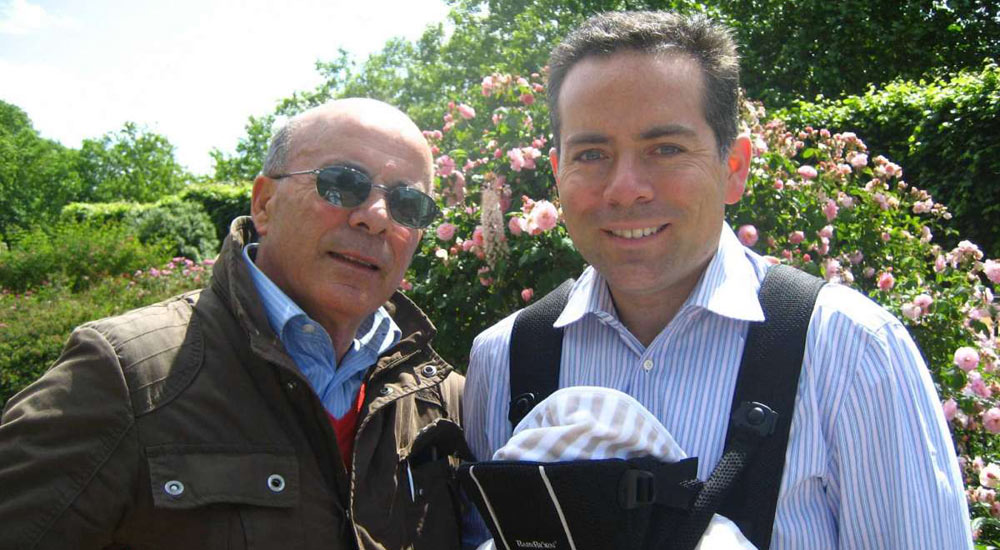
Giuseppe and Marco Peluso
What happened seriously affected Peluso Jr. He realized that constant monitoring of the heart rate is critical, but there is no publicly available technology for it. The banker readily threw a 14-year career, and in early 2012 he founded startup Qardio to solve the problem on his own. Rosario Ianella, who previously worked at Sun Microsystems and Oracle, joined Peluso.
The first ready-made product of the startup was the smart QardioArm tonometer. The Qardio team of engineers and designers was given the task of creating an accurate instrument that would be convenient to use. They coped with it brilliantly: a graceful gadget won the 2014 Red Dot Award and attracted everyone’s attention at CES the same year.
In parallel with the QardioArm was the development of the QardioCore heart rate monitor. The device won two awards at CES 2015 and the 2015 Red Dot Award for design. The official launch was postponed and occurred only in 2017.

Smart QardioCore heart monitor
Meanwhile, Giuseppe Peluso recovered and began to use both devices that his son's company developed for him.
What is QardioCore?
At first glance, the QardioCore cardiac monitor is no different from the ordinary wireless chest pulse meter. Like the usual electrocardiograph, it records the electric fields that arise when the heart is working. The first known chest heart rate monitor was invented by Seppo Sainaykangas, a professor at the University of Oulu, for the Finnish ski team. In 1977, he founded the company Polar Electro. In the 80s, intense training and pulse zones began to gain popularity among athletes, so the Polar devices came in very handy.
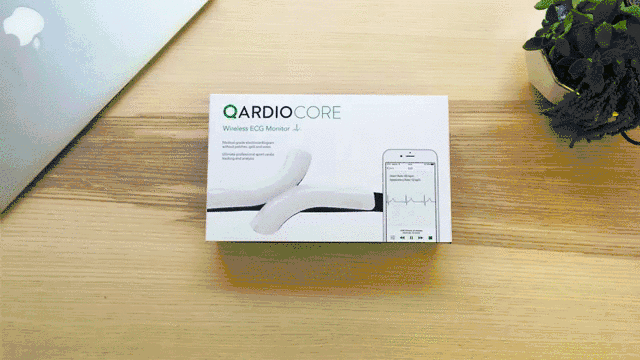
Wireless heart rate monitors are quite actively used in medical research. However, the device itself was not used directly in medicine. Hint in the name itself: the heart rate monitor is designed to measure and display only the pulse. The most common portable method of permanent recording of the electrical activity of the heart remains the daily ECG monitoring, developed by the American biophysicist Norman Halter in the middle of the 20th century.

To say that this is an inconvenient method is to say nothing. Holter monitoring assumes that the physician fixes the electrodes separately on the patient’s body and the device itself for 24–48 hours. Electrodes should not be allowed to fall off, so during the procedure, showers and active sports sessions are prohibited. Previously, Holter monitors were worn by a doctor; nowadays you can buy a simple monitor on the Internet for a few hundred dollars. Actual models will cost a couple of thousand. Both are problematic to effectively use without the constant help of a specialist: this is medical equipment, not a toy. Even for a geek.

QardioCore has no extra wires. The monitor is worn quickly and easily removed. When worn, he interferes no more than a wrist fitness tracker - that is, it does not interfere at all. From this point of view, QardioCore is a major innovation. This is the first consumer device that monitors heart activity and records an electrocardiogram using an application. There is enough charge for a day of continuous monitoring - therefore, the chances of detecting and recording a problem episode increase significantly.
Continuous monitoring is indicated for people with diabetes, with a predisposition to cardiovascular diseases, as well as the elderly and those suffering from obesity. Since the gadget is comfortable, it is easy to persuade even the most capricious on his toe.
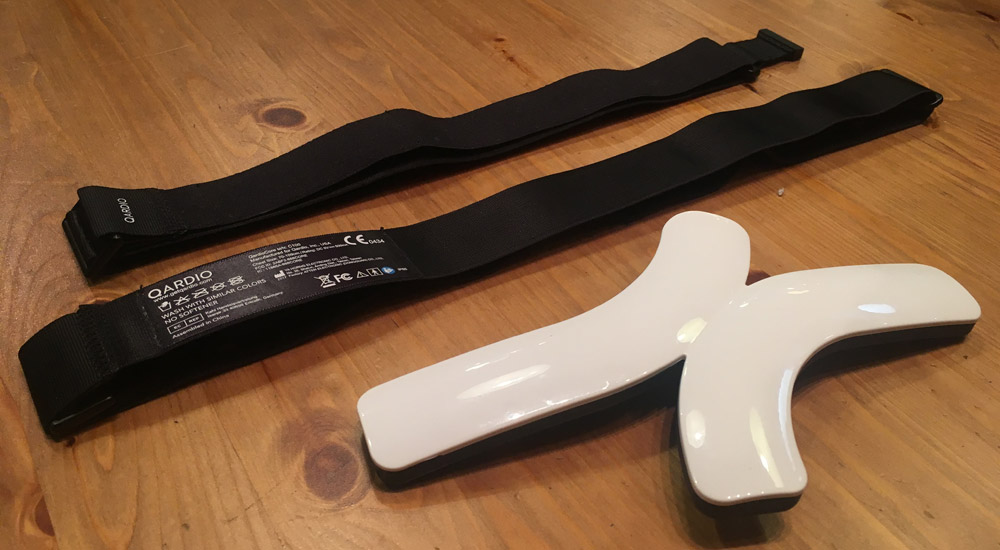
In addition to cardiac activity, QardioCore counts and records the following biometric indicators: heart rate variability, respiratory rate, skin temperature, and physical activity. Functions are designed for runners, fans of a healthy lifestyle and athletes. However, there is a place for medical benefits: the fact is that a number of problems with coronary insufficiency are easier to detect during intense physical exertion, when the heart beats more often. While the body is at rest, the potential danger may be unnoticed.
How it works
The first thing that strikes you is how beautiful QardioCore is. The heart rate monitor consists of two symmetrical halves, connected in the middle, like the letter X. It weighs only 130 grams, fits well in the hand, and the thought of walking with such a thing on the body all day does not cause rejection. On the back of the three "legs" are four electrodes that are not visible from the outside.
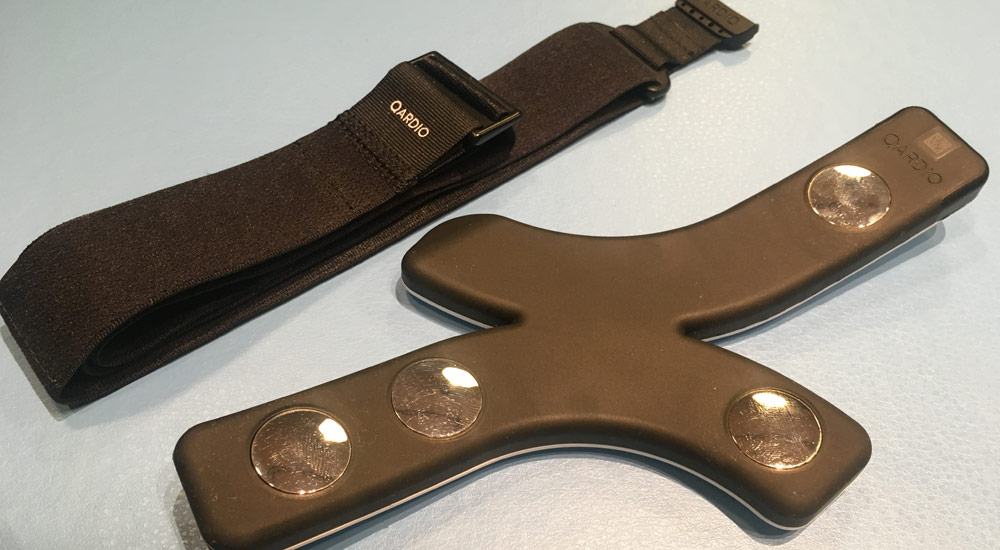
Qardio consciously makes attractive products. The minimalist design a la Apple serves as a “spoon of sugar” that Mary Poppins sang about. It is more pleasant to feel like an advanced gadget user than a patient with heart problems.
The gadget is attached under the sternum with an elastic strap. The box with the device comes with three adjustable straps of different lengths, which are suitable for a chest girth of 70–109 centimeters. The device can be used by both men and women. The upper arm of the heart monitor is placed under the laundry, since the electrodes must be in contact with the skin.
Important point: QardioCore is difficult to fasten on the sunken chest in the usual position. The problem is solved simply - the device must be turned upside down by the upper sensor and the corresponding setting is activated in the Qardio application.
There are no extra buttons on the heart monitor, only the charge indicator. It turns on when you fasten the strap to its left side. To turn it off, just click off the clip. When storing, pull the belt out of the device.

QardioCore is charged with a cable with a non-standard connector on one side and a USB output on the other. Lithium-ion battery, built-in and non-removable. Qardio promises that it should save 80% of its capacity after two years of daily use. One charge is enough, as mentioned above, for 24 hours of the gadget. The device case is water resistant and is protected from moisture according to IP65 standard. He is not afraid of spray and sweat, but you can not immerse the device entirely in water.
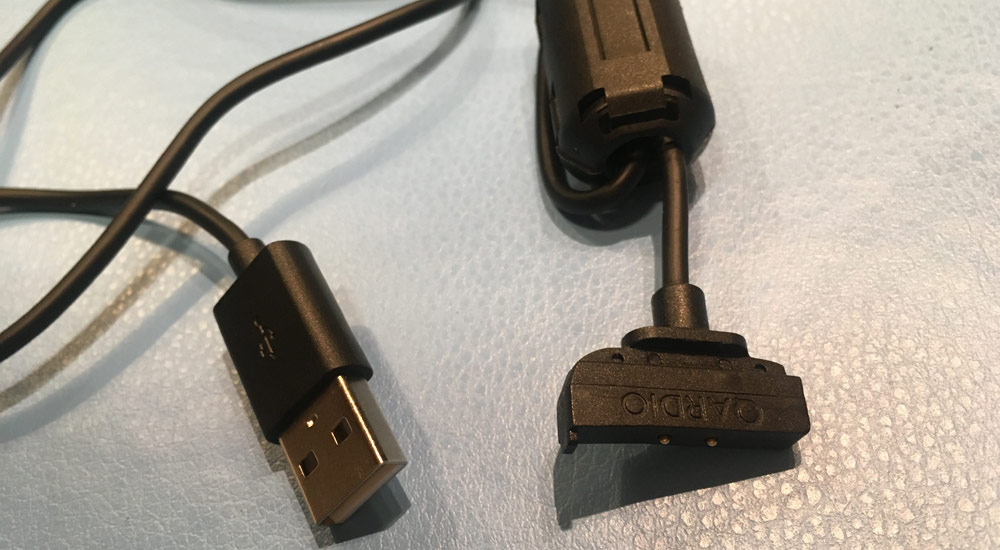
Straps for QardioCore should be regularly washed in cold water. The gadget itself should also be kept clean. The manufacturer recommends brushing it with a soft toothbrush or lint-free cloth and then drying it out with the same cloth. It is clear that the belts before this should be unfastened.
Skin for good contact with electrodes QardioCore does not need to be processed. It should be clean and dry, this ends the requirements. No nasty medical gel, and the electrodes of the gadget does not cause irritation. This device compares favorably with its "serious" medical fellows.

For operation, the heart monitor requires an iOS device with a system version not lower than 10.0. IPhone, iPad and iPod will do. There is still no support for Android-based devices. However, the QardioArm tonometer , which works in the same “ecosystem” and with the same application as QardioCore, has been compatible with Android for more than three years. Most likely, after a while it will reach the ECG monitor.
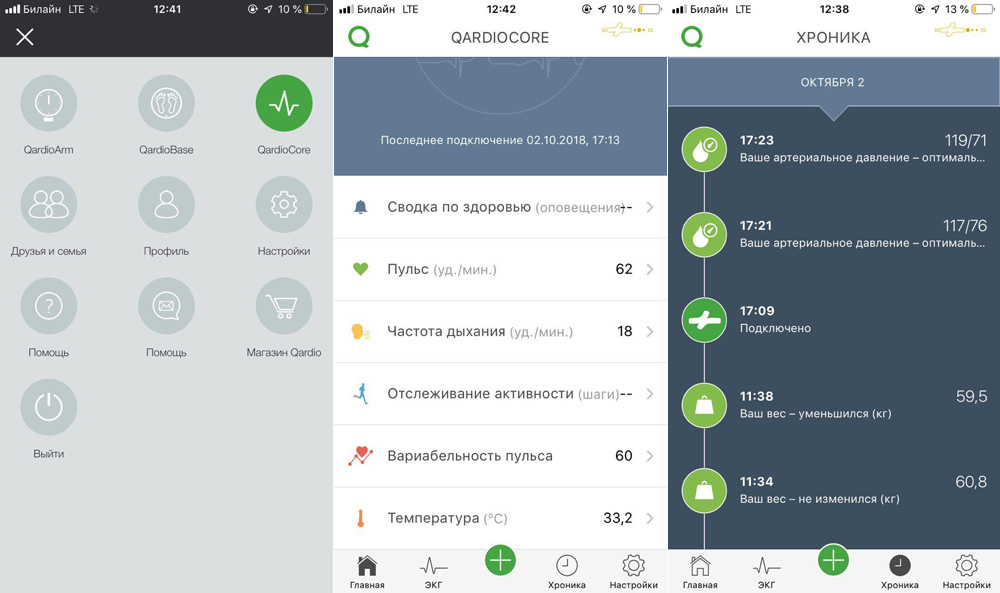
QardioCore is fully managed through a proprietary application. The monitor is connected to a smartphone or tablet via Bluetooth, and the cardiogram begins to be transmitted in live mode a minute after it is turned on. However, it is not necessary to keep Bluetooth on all the time, since the gadget has built-in memory. There you can record up to 10 hours of observations, and then download them to the application. The larger the amount of data, the longer it will take. If you have filled all the memory, then most likely, the synchronization will take a couple of hours. In parallel, synchronize data and write a live cardiogram is impossible.
The electrocardiogram is displayed on the ECG tab in increments of 26 mm / s and 10 mm / mV. These parameters change in the settings, as well as the scale - the schedule can be approximated. However, only 100% scale should be used for printing and making a diagnosis in order to avoid misinterpretation. Previously recorded cardiograms are available from the calendar, the icon of which is located in the lower left corner of the application. The application allows you to play them, but also with a restriction: the heart monitor will have to be turned off.
Sports functions of the heart monitor are available on the “home” tab of the application. Compared to Garmin GadgetsDetailed information is presented a little: pulse, respiration rate, number of steps taken and distance traveled, calories burned. The data shows the maximum, minimum and average values, as well as the history of the day, month and year.
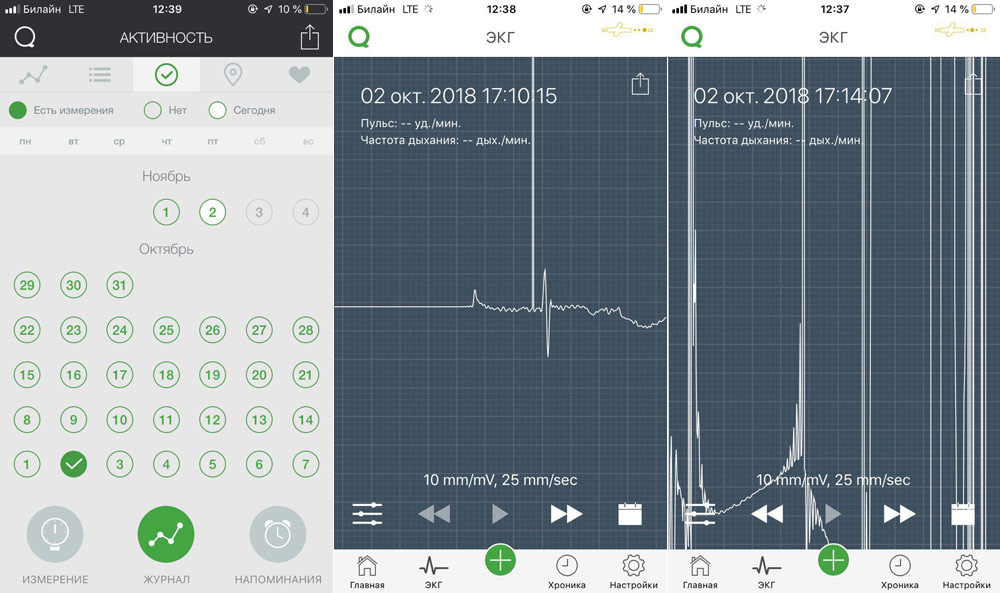
Advanced athletes are more likely to be interested in the ability to set target pulses to increase the effectiveness of training. The pulse is displayed both on the main tab and on the ECG tab. The target heart rate is set as a percentage or a specific value. The maximum pulse value is calculated using the standard formula of 220 beats minus age. The disadvantage is that you have to look at the display of the smartphone.
The QardioCore data from the Qardio App is synchronized with AppleHealth. The set is limited: it is the pulse, steps, respiration rate and body temperature. In the future, the list promise to expand.
By the way, the Qardio App shares data with Google Fit, but not with those generated by the heart monitor. So far, the above-mentioned QardioArm tonometer and smart startup scales - QardioBase (both the first and second generation) transmit their data.
Remote monitoring and accuracy of the heart monitor
“Instead of adjusting to sensors and medical devices, you now have a medical tracking system that fits easily into your life. We have created technologies and solutions that make healthcare personal as it should be, ”Marco Peluso appreciated the success of his company. But is QardioCore a full-fledged medical device?

Not certainly in that way. QardioCore approved by the Australian Drug Administration , has passed the certification of the European CE quality markand is still awaiting approval by the United States Food and Drug Administration; a number of medical companies cooperate with Qardio, and cardiologists assisted them in creating gadgets. However, in the startup itself, it is said that the device and its application do not replace professional medical expertise.
This explains the lack of detailed analytical functions in the application. Picooc smart scales are ready to give you advice on lifestyle, the MiFit app for Xiaomi devices readily analyzes your sleep. Even the QardioArm tonometer clearly shows with color that the pressure is not in order.
The analytics part for the user is opened when the owner of QardioCore becomes a client of a doctor who is registered in the QardioMD system. This system is the reverse side of the heart monitor. The medic who uses it receives “administrator” remote access to the patients' cardiac monitors, and sees what they write online.
All records that QardioCore makes for each patient are transferred to the doctor’s database. Already inside the system, the data are analyzed in great detail: cases of arrhythmia are detected, users are noted who have not downloaded the data in time. Patients are automatically sorted for serious, problem and healthy-looking, so that the doctor can correctly prioritize.
As a result, the person does not need to visit the cardiologist or the therapist once more; it is enough just to use a heart monitor. A very pragmatic approach: heart health is not a cold to self-medicate. On the other hand, personal responsibility for the health of the heart disciplines. Access to the ECG allows you to see for yourself why the heart “pricked” - and immediately show the record to the doctor.
It is clear that all this sounds too futuristic, if not fantasy - in the context of the Russian health care system. Nevertheless, Qardio actively cooperates with insurers , clinics , medical service providers , and medical software developers . The challenge is to fully integrate the Qardio “ecosystem” with existing electronic medical records. Any doctor can register on the QardioMD portal and test the system for free in action if he wants.

How accurate are the physician and patient with QardioCore? This was checked by the British cardiologist Craig Barr. He did researchIn the course of which he compared the cardiac monitor with the “gold standard” of electrocardiography, the GE Healthcare MAC 1200 electrocardiograph.
Let's start with the characteristics: QardioCore has one lead and writes a single-channel cardiogram with a frequency range from 0.05 to 40 Hz, with a sampling frequency of 600 Hz (600 signals per second) and a resolution of 16 bits. MAC 1200 has the following parameters: 12 leads, 6/12-channel ECG, frequency range 0.04–150 Hz, sampling rate 1000 Hz (1000 signals per second).
The study involved 85 patients, of whom 57 are men and 28 women. Only a third of the group had a healthy body mass index, and these were mostly older and middle-aged people. They were all monitored for cardiac arrhythmias. That is, roughly speaking, it was the main target audience of QardioCore - those who should follow the heart because of age and weight.
The study itself was carried out as follows: QardioCore and MAC 1200 electrodes were attached to the patient's body. The instrument clock was synchronized and then the electrocardiogram was turned on. When the next participant's turn came up, the belt was changed for QardioCore and the device itself was cleaned with an ethanol solution.
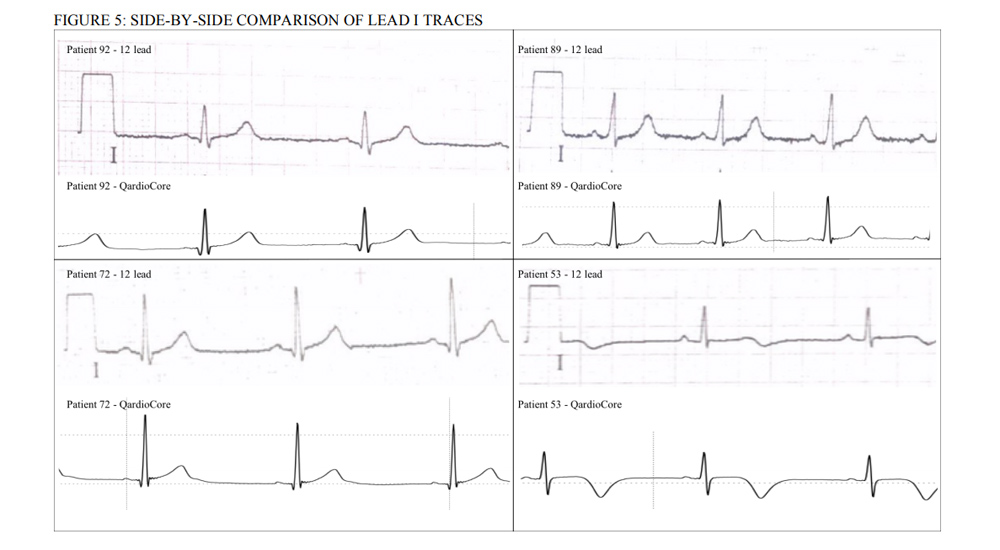
On each pair of electrocardiograms obtained, the ventricular QRS complex and the RR interval were compared. The correlation was 0.93 and 0.99 respectively. According to the study, Barr concluded that the accuracy of QardioCore allows us to really use the device for medical research of patients. With the proviso that, in practice, the patients themselves will wear a heart monitor - and during the study it was fixed by a specially trained technician.
Of course, the initiative of Qardio is very ambitious, and it is obliged to cause doubts among skeptics. So far, the Qardio team has successfully implemented all its plans for consumer medical devices, so we wish them good luck with the implementation of the monitoring plan.
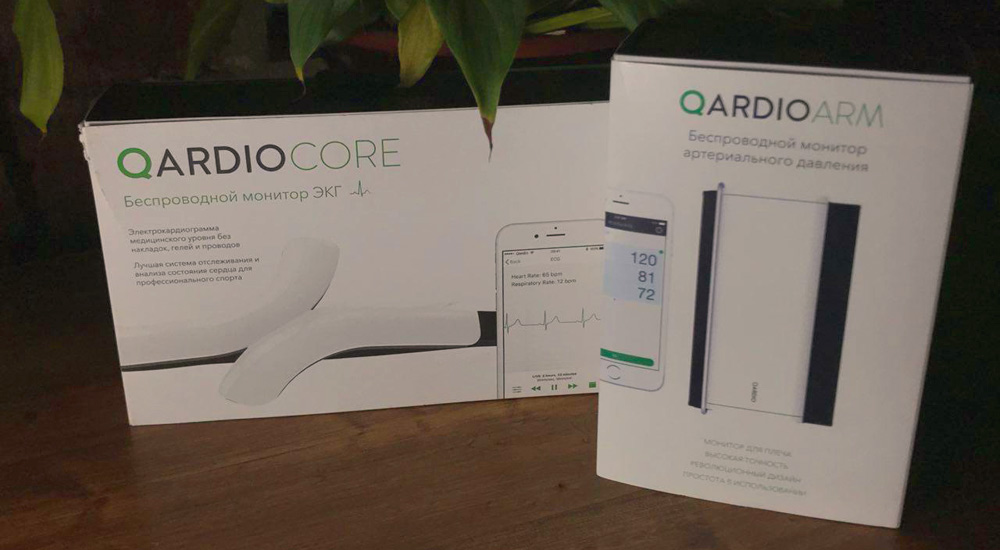
You can purchase QardioCore and other Qardio devices in Madrobots.ru with a 20% discount on promo code QXH20 (the discount is valid until 11/15/2018 and is not cumulative with other discounts).


